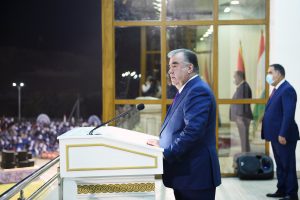This week Tajik authorities officially registered five candidates for the upcoming presidential election set for October 11. There were no surprises.
Tajikistan’s Central Election Commission registered Rustam Latifzoda of the Agrarian Party; Abduhalim Ghafforov of the Socialist Party; Miroj Abdulloev of the Communist Party; Rustam Rahmatzoda of the Party of Economic Reforms; and President Emomali Rahmon of the People’s Democratic Party.
The commission has not yet decided on the Democratic Party’s Saidjafar Usmonzoda and it has decided against Faromuz Irgashev, a 30-year-old lawyer from Khorog. The commission says he did not submit the required documents by the deadline.
Per Tajik law, in order to register for a presidential election a candidate has to collect the signatures of at least 5 percent of the electorate. According to Asia Plus, an independent Tajik news outlet, that figure rests at 245,100. That’s a significant hurdle for any new or independent candidates.
Eurasiant has an interview with Irgashev that is well worth reading.
Last week I wrote that it was worth watching how far Irgashev’s attempt at the presidency would go; I should have noted my expectation that the run would be short. It goes without saying that the upcoming election will be a democratic performance, but not an actual democratic exercise.
Just look at the field of candidates.
The Agrarian Party secured the second-most seats in the Tajik parliament in March — seven out of 63. For the presidential race, the party put forward 60-year-old Rustam Latifzoda, who has served in parliament since 2010. The Party of Economic Reforms, which snagged five seats in parliament in the March election, has put forward Rustam Rahmatzoda (Qudratov) who is also in parliament. Miroj Abdulloev has been head of the Tajik Communist Party since 2017. The 2020 election will be Abduhalim Ghafforov of the Socialist Party’s third appearance in a Tajik election. Ghafforov is reportedly an official in the Education Ministry. In 2013, he gathered just 1.48 percent of the vote. The Democratic Party’s Saidjafar Usmonzoda also ran in the 2013 election and is expected to be approved to appear on the 2020 ballot.
Eurasianet recently characterized the field of candidates as “handpicked no-names whose campaign statements are likely to be limited only to praising the president.” Campaigning begins September 15.
In the four previous elections in which Rahmon was on the ballot, he’s always “won,” usually in a landslide: 1994 with 59.5 percent; 1999 with 97.6 percent; 2006 with 79 percent; and 2013 with 83.9 percent. It was in the 2006 election that the current array of state-approved parties emerged, though none actually presents a challenge to the Rahmon regime and the status quo.
Based on the previous elections, the question isn’t whether Rahmon will be hailed the victor on October 11 but the margin by which he wins.

































